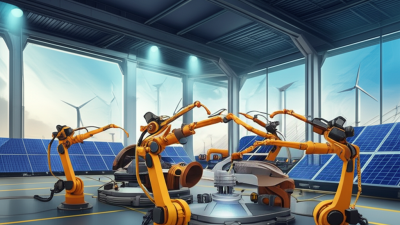Leave Your Message
In the evolving landscape of sustainable alloy manufacturing, Silicon Manganese emerges as a pivotal component, significantly influencing the properties and performance of alloys. As global steel production continues to rise, with data projecting an increase to 1.9 billion tons by 2026, the demand for high-quality Silicon Manganese remains critical. This strategic alloy not only enhances the strength and toughness of steel but also plays a crucial role in reducing carbon emissions during production. Reports indicate that the global market for Silicon Manganese is poised to grow at a CAGR of 5.6% from 2021 to 2028, driven by its essentiality in producing eco-friendly and high-performance materials. "全球领先制造,中国优质出品" encapsulates the promise and potential of China as a leading producer in this sector, highlighting the significance of Silicon Manganese in paving the way for innovative, sustainable alloy solutions that align with both industry needs and environmental considerations.

Silicon manganese plays a crucial role in alloy production, becoming increasingly significant in sustainable manufacturing practices. The dynamics of the silico manganese market are evolving, underpinned by the current trend of rising demand and price fluctuations. As per the recent analysis, silico manganese prices now range between USD 1100 per kg due to its essential function in the steelmaking process. The demand for silico manganese is primarily driven by its application in carbon steel and alloy steel, which are vital for various industrial applications.
Future outlooks suggest that the silico manganese market will continue to witness growth, with reports indicating that the ferroalloys market, including silicon manganese, is poised for strong performance. This is evidenced by a projected growth rate of around 5.5% for the global ferrosilicon market from 2023 to 2030. However, challenges remain, particularly in the manganese ore sector, which is facing significant price declines and operational disruptions. The complexity of global supply chains could impact the availability and pricing of key materials needed for alloy production, necessitating strategic planning and adaptation within the industry to mitigate risks associated with price volatility and supply disruptions.
The manufacturing industry is undergoing a significant transformation, particularly regarding the use of silicon manganese (SiMn) in alloy production. Traditional SiMn alloys, while effective, are often energy-intensive and not environmentally friendly. As companies shift towards sustainability, innovative alternatives are emerging. According to a recent report by the International Journal of Metal Science and Engineering, alternative alloying elements like ferrosilicon, aluminum, and even bio-based materials are being explored. These alternatives not only reduce carbon emissions but also enhance the mechanical properties of alloys, making them more suitable for modern applications.
One promising development is the use of composite materials that integrate silicon with renewable resources. Research indicates that using biochar as a silicon source can lower the carbon footprint associated with traditional SiMn production by up to 30%. Additionally, advancements in electrical arc furnace technology facilitate the use of lower grade ores, further minimizing the environmental impact. A study from the Global Steel Innovations Forum highlights that integrating these innovative alternatives can yield high-strength alloys while significantly lowering energy consumption during the production process. This dual benefit of performance enhancement and sustainability positions these alternatives as viable contenders in the future of alloy manufacturing.
Silicon manganese is a critical alloy used in steel manufacturing, but its production can have significant environmental impacts. According to a recent report by the International Energy Agency, the steel industry alone accounts for approximately 7% of global CO2 emissions. As industries push towards sustainability, evaluating alternatives to silicon manganese is essential. Researchers are exploring options such as ferrosilicon and other low-carbon alloys, which could reduce emissions while maintaining the necessary material properties.
When considering sustainable alternatives, it’s crucial to conduct a full life cycle analysis (LCA) to assess environmental impact accurately. The World Steel Association highlights that adopting more energy-efficient production methods can lower emissions by up to 30%. Investing in recycling technologies can also contribute to a circular economy, reducing the need for raw material extraction and its associated environmental degradation.
Tip: When selecting materials for alloy manufacturing, prioritize those that have a lower carbon footprint and are sourced from sustainable practices. Additionally, consider collaborating with manufacturers committed to reducing their environmental impact, as this will enhance your sustainability profile and possibly reduce costs in the long term.
The landscape of alloy manufacturing is undergoing a significant transformation with the integration of emerging technologies that focus on sustainability and efficiency. One of the key materials at the forefront of this evolution is silicon manganese. According to a report from MarketsandMarkets, the global silicon manganese market is expected to grow at a compound annual growth rate (CAGR) of 5.2% from 2021 to 2026. This surge can be attributed to the increasing demand for high-strength, lightweight materials in industries such as aerospace and automotive, where enhanced sustainability practices are essential.
Advancements in alloy manufacturing processes, such as the development of electric arc furnaces (EAF) and enhanced refining techniques, are driving changes in silicon manganese utilization. These technologies enable manufacturers to reduce waste and lower energy consumption by approximately 30%, as reported by the International Energy Agency. Furthermore, the implementation of digital tools for process optimization contributes to the efficient management of raw materials, minimizing the ecological footprint. Industries are increasingly leaning towards sustainable alloy solutions, which not only meet regulatory standards but also appeal to environmentally conscious consumers. As the intersection of innovation and sustainability continues to evolve, silicon manganese is poised to play a pivotal role in the future of alloy production.
The global alloy manufacturing industry is undergoing a significant transformation, driven by increasing environmental awareness and shifting market dynamics. As industries prioritize sustainability, the demand for alternative alloys with lower ecological footprints is rising. Silicon manganese, a pivotal component in steel production, is being scrutinized as manufacturers explore more eco-friendly alternatives. This shift is not only a response to regulatory pressures but also to consumer demand for greener products, prompting alloy producers to innovate and adapt.
The market dynamics are influenced by several factors, including the volatility of raw materials and fluctuating energy costs. As traditional sourcing methods face challenges, companies are investing in new technologies and processes to improve efficiency and sustainability. This transition embraces the development of alternative alloys that could replace silicon manganese in specific applications, offering lighter weights, enhanced durability, and reduced carbon emissions. By leveraging advancements in metallurgy and recycling practices, the industry is poised to meet the evolving needs of a more environmentally conscious market, ensuring a sustainable future in alloy manufacturing.
| Region | Market Size (Million USD) | CAGR (%) | Alternative Alloys Demand (Metric Tons) | Sustainability Index |
|---|---|---|---|---|
| North America | 450 | 4.5 | 50,000 | 8.2 |
| Europe | 550 | 5.2 | 70,000 | 7.9 |
| Asia-Pacific | 750 | 6.1 | 100,000 | 9.0 |
| Latin America | 300 | 3.8 | 30,000 | 6.5 |
| Middle East & Africa | 200 | 3.3 | 20,000 | 5.8 |
